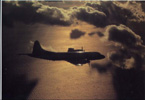mdiehl
Posts: 5998
Joined: 10/21/2000
Status: offline

|
quote:
Obviously that practice in China didn't do much for them against the US Navy in real combat because in 1942 the IJN got repeatedly bested by the US Navy - open any book for the source on that.
He could look at Guadalcanal by Richard Frank for the summary stats too, since he has the book. The observations about superior USN deflection shooting are available in Lundstrom's "The First Team" series in several places.
In the end though this general argument seems to precipitate two positions. One in which one considers a few older histories with general claims about superior IJN pilots and aircraft and repeats, without really looking into much detail, that the IJN planes and pilots were better. The other held by people who wonder how that can be true in the face of extant empirical data.
quote:
1. War Games are exactly that! Those gunnery games and Fleet Exercises held every year were beneficial but did not help once a new war broke out. They did provide great potential for immediate Doctrinal changes after Pearl Harbor and it took the Carrier-minded Admirals to force change. Additionally, practice A2A is beneficial but did not reflect life-or-death combat.
That assessment of the value of war games is not supported by facts. First, you can note that Thach and Flatley invented the beam defense and used it in 1941 during the Army-Navy games. In that contest, the beam defense (aka "Thach weave") was used successfully by USN pilots to counter the superior speed characteristics of the P40s. Mutual support as a general doctrine was in effect among USN pilots before Pearl Harbor. If you look at John Lundstrom's "The First Team at Guadalcanal" you can read USMC pilots interviewed who noted that their propensity for mutual cooperation gave them an edge over the Zeroes even though they never employed or had been instructed specifically in the use of the beam defense.
Second, during world war 2 USN pilots had an advanced tactical pilot school that was later resurrected in the 1960s as the "Top Gun" program. The basic premise of this program, and it is still used today, is that rigorous simulation DOES in fact provide a substantial benefit to trained pilots for use in combat. Therefore the suggestion that the only experience that matters is live-fire combat experience not only is contradicted by the USN experience in late WW2, and in Viet Nam, but is also contradicted by the assumptions used by the current United States Navy for training pilots.
quote:
2. The Japanese started with nearly 700 combat hours per pilot. What do you call that? I do not care if it were against the Chinese with inferior aircraft. Those were COMBAT missions. They provided the Japanese with invaluable experience that led to superior Carrier Air Group tactics. This is why American CV Strike Rule was put in place to reflect reality.
The Japanese did not employ superior Carrier air group tactics. In detail:
1. the Japanese used a 3 plane vic that was less useful than the 4 plane 2-section formation used by the USN.
2. Japanese did not stress mutual support in combat to the degree that the USN did prior to the US entry into the war. As late as 1943 Sakai's colleagues were complaining that superiors weren't willing to install a decent radio in their aircraft to facilitate plane to plane communication. The official higher up rebuttal to this request was "What has a radio got to do with shooting down enemy aircraft?"
3. Very few Japanese pilots had more than 100 hours of actual combat experience prior to the US entry into the war. Their experience was extensively in training, and unfortuntaley for them some of the training was simply flawed... the use of the 3-plane vic, the inattention to deflection shooting, and the lack of emphasis on mutual support.
4. Experience facing Chinese pilots may have been of no value in dealing with other Allied aircraft. Most of the Chinese pilots engaged by Japanese aviators were fought in 1937 and 1938. At the time, Chinese pilots used (a) different (inferior) aircraft than allied ones, (b) line abreast combat formations, (c) did not stress mutual support, and (d) had substantially less training than US pilots. Any lessons derived from fighting the Chinese, OTHER THAN managing a damaged aircraft, may have been counterproductive when fighting the other western powers.
quote:
3. Also, do not confuse doctrine with experience. The DB doctrine developed by American officers (that 70-80* Dive) prior to the war was excellent. Other nations took it, modified it, and made it their own. The Japanese method of diving from 60* was just as effective but different. American pilots were very brave in carrying out their attacks--this reflects morale and not experience.
US pilots were more effective in delivering dive bombing attacks. This is an example of US training being better than Japanese experience.
quote:
4. You mention 'superior' doctrine of the Americans? If the Zeros and their F4F counterparts were 'so equal' in quality, then why did Jimmy Thach come up with the Thach Weave? This was developed during the OPENING months of the war. Guess that goes against some prevailing sentiment here...
That is an incorrect statement. Thach and Flatley invented the beam defense (aka Thach Weave) in summer 1941 for use in the USArmy vs USNavy wargames. The initial concern was combat reports from the ETO vis the qualities of the ME-109 and more recent intel that the Japanese had an aircraft that was exceptionally maneuverable.
Thus your suggestions that (a) training could not prepare USN pilots adequately for engaging Japanese pilots, (b) the beam defense was worked out as a response to combat experience engaging in A6Ms, and (c) a mutual support doctrine was not in effect at the start of the war are all rebutted at once.
quote:
5. If they were SO equal then explain the radical difference in qualities of the Torpedo Plane Doctrine. The American pilots had a TERRIBLE plane AND torpedo. They were terribly brave (read morale) but didn't stand a chance.
There was nothing wrong with USN torpedo plane *doctrine.* The TBD was known to be obsolete and the TBF was through design and Y-prototype by the time the Japanese attacked Pearl Harbor. Sometimes you just don't have the aircraft that you want when you want it.
quote:
The Japanese were superior here as well. Through the Battle of Santa Cruz, no one did the scissors attack better.
That comparison does not seem to be supported by anything. The US strikes at Midway broke up into scissors attacks. It was standard doctrine in the USN and the pilots attempted to emploty it. I warrant that an unescorted Japanese torpedo plane strike met by a robust formation of F4Fs would have been equally ineffective at the time.
quote:
6. Simple reality is that the American CV Air Groups needed TIME to prepare for what they faced: experience, doctrine changes, and new aircraft gave them the chance that they exploited at Midway. 'Bull' Halsey himself said something to that effect.
That is incorrect. It was not the reality nor have you made the case that SBD pilots' recon and strike missions over Tarawa somehow made F4F pilots more capable at combating the A6M. It is at the least a wierd sort of chemistry that has SBD attacks on a land installation improving F4F drivers knowledge of the flight characteristics of the Zero.
Bull Halsey's complaint (and Thach's) in late 1942 was that the F4F did not have sufficient acceleration and power. They were disappointed that by their assessment (which was incorrect) that American F4Fs were "only" destroying 3 Zeroes for every F4F shot down. The real kill ratio through August 1942 was closer to 1:1.
The history has in part been nuanced by expectations. If one designed a game to convey the "look and feel of the war" to Halsey for example the game would have the USN slaughtering Zeroes wholesale from the outset but the USN player would be told he was losing the war.
quote:
I could go on but then I might be attacked like Ron does. Everything I have covered here can be found in Kaigun, Sunburst, and Frank's Guadalcanal.
The claims that you make are not suppored by Richard Frank's Guadalacanal.
< Message edited by mdiehl -- 12/9/2005 10:10:00 PM >
_____________________________
Show me a fellow who rejects statistical analysis a priori and I'll show you a fellow who has no knowledge of statistics.
Didn't we have this conversation already?
|
 Printable Version
Printable Version

















 )
) 
 New Messages
New Messages No New Messages
No New Messages Hot Topic w/ New Messages
Hot Topic w/ New Messages Hot Topic w/o New Messages
Hot Topic w/o New Messages Locked w/ New Messages
Locked w/ New Messages Locked w/o New Messages
Locked w/o New Messages Post New Thread
Post New Thread